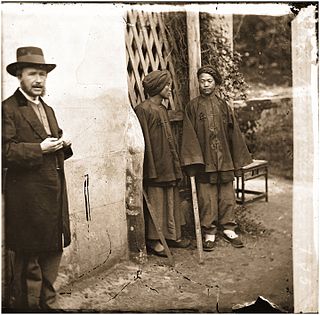Felix Bonfils
Félix Bonfils | |
|---|---|
 Bonfils, self-portrait | |
| Born | Félix Adrien Bonfils 8 March 1831 Saint-Hippolyte-du-Fort, France |
| Died | 9 April 1885 (aged 54) Alès, France |
| Occupation(s) | Photographer and publisher |
| Years active | 1867– |
| Known for | early Middle East photography |
| Spouse | Marie-Lydie Cabanis (m. 1857) |
Félix Adrien Bonfils (8 March 1831 – 1885) was a French photographer and writer who was active in the Middle East. He was one of the first commercial photographers to produce images of the Middle East on a large scale and amongst the first to employ a new method of colour photography, developed in 1880.
Life and career
Bonfils was born in Saint-Hippolyte-du-Fort and died in Alès. As a young man he worked as a bookbinder. [2] In 1860, he joined General d'Hautpoul's expedition to the Levant, [3] organised by France following the massacre of Christians in the civil conflict between Christians and Druze in Mount Lebanon and Damascus. On his return to France, it is thought that Bonfils was taught the heliogravure printing process by Abel Niépce de Saint-Victor and opened a printing office in Alès in 1864. [2] [3] Soon after returning from Lebanon, he became a photographer.
In 1857, he married Marie-Lydie Cabanis. When his son, Adrien, fell ill, Bonfils remembered the green hills around Beirut and sent him there to recover, accompanied by his mother. [2] The family moved to Beirut in 1867 where they opened a photographic studio called "Maison Bonfils". [4] [5]
Maison Bonfils produced thousands of photographs of the Middle East. Bonfils worked with both his wife and his son. Their studio became "F. Bonfils et Cie" in 1878. They photographed landscapes, portraits, posed scenes with subjects dressed up in Middle Eastern regalia, and also stories from the Bible. [4] Bonfils took photographs in Lebanon, Egypt, Palestine, Syria, Greece and Constantinople (now Istanbul). [5] While Bonfils produced the vast majority of his work, his wife, Lydie, and son Adrien were also involved in photography produced by the studio. As few are signed, it is difficult to identify who is responsible for individual photographs. [3] Lydie is thought to have taken some of the studio portraits, especially those of Middle Eastern women, who were more inclined to pose for a female photographer. [2] Adrien became more involved in the landscape photography at age 17, when Félix returned to Alès to have compiled collections of their photographs published and then to open a collotype printing factory. [6] Félix died in Alès on 9 April 1855.
Bonfils was amongst the first photographers to employ the new technique of Photochrom, a photographic colour printing technique, developed in 1880. [7] Maison Bonfils was one of the most prolific studios in the Middle East in the late 19th-century. [8] After Félix's death, the studio continued to produce photographs by the Bonfils family, first under Adrien's management, then Lydie's, until her death in 1918. [9]
Work

After settling in the Near East, Félix Bonfils took some panoramic photographs of Constantinople and Damascus. [10] His work became well known among tourists that travelled to those countries because they bought photographs as souvenirs. In 1872 he published the album Architecture antique (by Ducher press) after presenting some of his pictures to the Société française de photographie. He later re-opened a studio in Alès (France) from which he would publish Souvenirs d'Orient; his best-known work. [2]



























